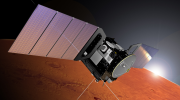As you read this, at 08:09 CET, Mars Express will be making its closest-ever flyby of Phobos!
MEX is transmitting a continuous radio signal across 208 million km of space, which is being tracked and received by NASA’s 70m station at Madrid. The recording will enable scientists to precisely reconstruct the spacecraft’s trajectory and, hence, know the gravitational influence of Phobos.
The one-way signal time is 11 minutes, 35.4 seconds right now.
If you were standing on the (lumpy) surface of Phobos and looked up, the animation below shows more or less what you would see: ESA’s spacecraft as a pinpoint of light slowly but steadily advancing across the sky.
This animation shows the view in real time from the surface of Phobos.
A few minutes ago, I got an update from the Mars Express Dedicated Control Room at ESOC: everything is going as planned!
The tracking today will continue through until this evening; NASA Goldstone takes over tracking at 11:02 GMT (12:02 CET) until 19:00 GMT (20:00 CET). ESA’s New Norcia station will also shadow track starting at 17:06 GMT (18:06 CET). The MEX transmitter will remain on until tomorrow at 01:12 GMT (02:12 CET).
Months of preparation have culminated in a successful and – As hoped for! – relatively quiet tracking and flyby operation. Best wishes and well done to the ESA and NASA pros who made this work.
This animation shows how the flyby would appear from a vantage point near Mars Express, with Phobos passing by beneath. The relative movement between the spacecraft and moon has been speeded up 10x faster than actual.





Discussion: 2 comments
Job well done! It came as a surprise to me to find out NASA has a presence in Madrid 😉
So does ESA! 🙂
https://www.esa.int/About_Us/ESAC
https://www.esa.int/Our_Activities/Operations/Cebreros_-_DSA_2